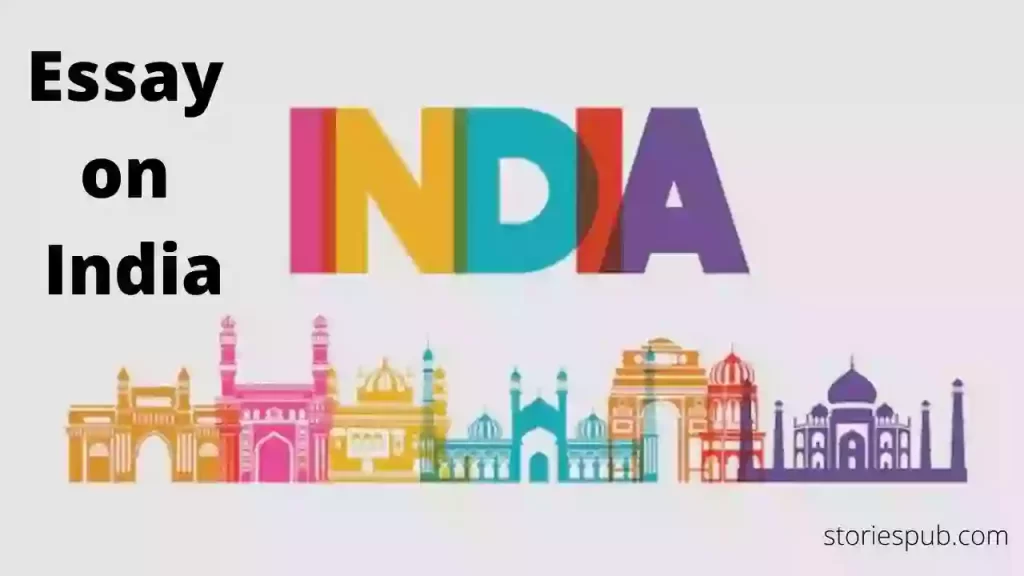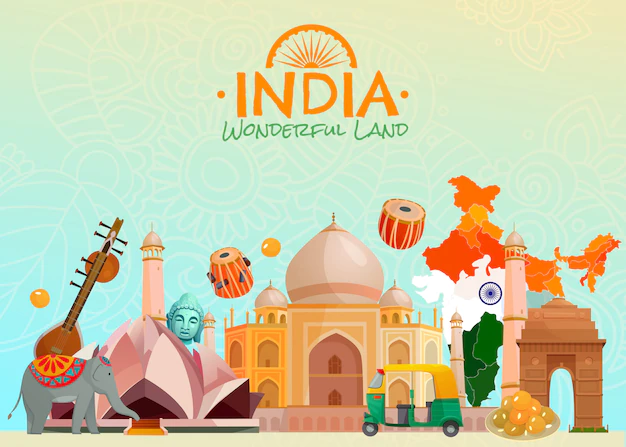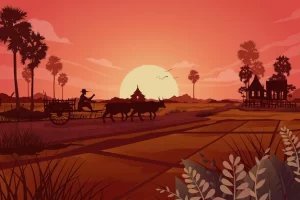Complete Essay on India in English for the students

India is one of the most diverse and populous countries in the world, with over 1.3 billion people living in over 29 different states and territories. It is also one of the oldest civilizations in the world, with evidence of human activity dating back to 3300 BC. India has a rich cultural heritage, with Hinduism being the dominant religion, and various languages are spoken across its vast territory. The country is also home to several famous tourist destinations, including Mumbai (formerly Bombay), Delhi, Agra, and Varanasi. India has a significant role to play in the world economy, both as a manufacturing hub and as a destination for tourists. In this complete essay on India, we will explore all these topics in detail!
India History
India is one of the oldest inhabited countries on Earth, and it has a rich and diverse history. India is home to many important cultural and religious sites, including the birthplace of both Buddhism and Hinduism. The country is also home to some of the world’s most popular tourist destinations, such as Mumbai (formerly Bombay) and Delhi. India has a long and complicated history, which has made it an essential part of the world economy and culture. Here is a complete essay on India:
Indian Geography
India is the world’s second-largest country by area after Russia, with a total area of 1,287,590 sq km (503,219 sq mi). It shares borders with Pakistan to the south-east; China, Nepal, and Bhutan to the northeast; Bangladesh and Myanmar (Burma) to the east; and Sri Lanka to the south-west. The Indian subcontinent was once much larger than it is now, but parts of it were divided among various countries in 1947 after independence from Britain.
India’s climate is mainly tropical, but there are variations in altitude, ranging from coastal lowlands in the south to high mountains in the north.
The country has four main climatic zones:
- The hotter and more humid zone in the south-east
- The semi-arid zone in the north-west
- The cool, dry, and subcontinental zone in the central region
- The subtropical zone in the south
The country has a variety of soils, including some of the most fertile in the world.
Indian wildlife includes tigers, elephants, leopards, lions, rhinoceroses, buffaloes, civets, sloth bears, monkeys, and many other animals. India is home to a number of beautiful tropical islands, including Sri Lanka, Mauritius, and Seychelles.
Indian Culture

India has a rich and diverse culture shaped by its history and geography. Indian culture is characterized by its religions – Hinduism and Buddhism – as well as its traditional values such as honoring ancestors, maintaining family ties, and observing social norms. Indian art is also distinctive for its use of colors, patterns, and textures. Indian classical music is widely enjoyed around the world.
Indian food is widely enjoyed around the world for its varied spices, flavors, and textures. Indian cuisine includes items such as tandoori chicken, chaat masala, pulao (rice dishes), biryani (a type of rice and meat dish), and naan bread.
Indian literature is also highly acclaimed, with authors such as Rushdie, Tagore, and Gandhi receiving international acclaim. Indian films are often trendy, with Hollywood productions such as Avatar and Slumdog Millionaire being based on Indian stories and characters.
Indian culture has had a significant impact on the world, positively and negatively. Indian culture has contributed to the development of modernity and democracy worldwide while also influencing aspects of Western civilization, such as fashion and technology. However, there have been concerns about India’s treatment of its minorities and its poor record on human rights.
India’s old Ancient Names
Nabhivarsha: India is referred to be a Nabhivarsha in ancient writings. The name is given for two reasons. Nabhi was the guy’s son who ruled over all of the Earth. It was called Nabhivarsha because Nabhi controlled India. In Sanskrit, the word “nabhi” also denotes “center.” India seems to be the navel or center of the Earth as viewed from space. The name Nabhivarsha comes from this.
Jambudvipa: name Jambudvipa roughly means “Land of the Jambu Trees.”
Aryavarta: Aryavarta was the term for the northern area of India, not the entire country.
Hindustan: The Persians dubbed India Hind or Hindustan, which is still used today.
Bharat: India is officially known as Bharat, or the Republic of India, after its ruler Bharata.
India: The most common and official name for the country is India.
Hodu is a Biblical Hebrew term for India that appears in the Old Testament.
Geography and Culture
The geographical area now known as India is one of the most diverse and populous countries on the planet. Spanning over 3,287,267 square kilometers, it is a landmass larger than France, Germany, Belgium, and the United Kingdom combined. India’s population is over 1.3 billion people and is projected to be over 2 billion by 2050.
India’s culture is as diverse as its geography. The country has a rich heritage of classical Indian literature, music, dance, and religious traditions deeply rooted in Hinduism and Buddhism.
Food in India is a significant part of its culture and history. The country is home to a vast array of culinary traditions, including several regional specialties such as tandoori chicken in Mumbai or Batata Wada in Hyderabad. Festivals in India are also some of the most colorful and lively celebrations. Some of the most famous festivals include Diwali in Mumbai, Ram Navami in Ayodhya, and Dusshera in Lucknow. India’s importance to world affairs is also unmistakable. It is home to several key international organizations, such as the United Nations and UNESCO, and several major universities.
India is a country of extraordinary diversity, with many landscapes, climates, and ecosystems. From the snow-capped peaks of the Himalayas to the tropical coastal forests of Kerala, India has something to offer everyone who visits it.
There is no one way to experience India, and each traveler is sure to discover something new about the country and its people. Whether you are looking for an exotic travel destination or a fascinating cultural experience, India will leave a lasting impression on you.
About Indian Flag
India’s national flag is a horizontal rectangular tricolor of India saffron, white, and green, with the Ashoka Chakra, a 24-spoke wheel in navy blue, in the center. On 22 July 1947, the Constituent Assembly accepted it in its current form, and on 15 August 1947, it was designated as the official flag of India.
According to the Flag Code of India, the Indian flag has a width:height aspect ratio of 3:2 according to the Flag Code of India. The flag’s three horizontal bars (saffron, white, and green) are all the same size. The Ashoka Chakra contains twenty-four spokes that are equally spaced.
The top band of the Indian national flag is saffron, symbolizing the country’s strength and courage. With Dharma Chakra, the white center band represents peace and truth. The final ring, which is green in color, represents the land’s fertility, growth, and auspiciousness.
The Indian national anthem, “Jana Gana Mana,” was also adopted in 1947. Written by Rabindranath Tagore, the song is based on ancient Hindu texts and celebrates India’s culture and heritage. The anthem is often sung at patriotic events or during religious services.
Official Language and other Languages
India is the world’s second-most populous country, with over 1.3 billion people, and it is also the world’s largest democracy and has a rich cultural heritage. The official languages of India are Hindi and English, but there are also many other languages spoken in India, including Bengali, Gujarati, Kannada, Malayalam, Tamil, Telugu, and Urdu.
India Geographical Diversity
India is a land of immense geographic diversity, with numerous regions and cultures. India’s rich and varied culture, with many festivals and important religious ceremonies. The country is also a significant contributor to world culture.
Geography
The geographical diversity of India is remarkable. The country encompasses the Himalayas, the Indo-Gangetic Plain, the Thar Desert, and the tropical Andaman and Nicobar Islands. India also has a coastline on the Arabian Sea, the Bay of Bengal, and the South China Sea.
Culture
India is home to an extraordinary variety of cultures. These cultures reflect India’s history, geography, and religion. Indian culture includes Hinduism, Buddhism, Jainism, Sikhism, Islam, Christianity, and various tribal customs. Indians are proud of their diverse heritage and celebrate their cultural traditions with festivals such as Dussehra (Diwali), Diwali night (Festival of Lights), Holi (the Festival of Colors), Eid al-Adha (the Feast of Sacrifice), and Christmas.
Religion
India is a land of religious diversity. The predominant religion in India is Hinduism, which comprises about 80 percent of the population. Other significant religions include:
- Islam (about 15 percent of the population).
- Christianity (about 2 percent of the population).
- Sikhism (about 1 percent of the population).
India also has a large number of tribal religions.
National Symbol
The national symbol of India is the lion. Since ancient times, the lion has been a national symbol of India and is revered by many Hindus. The lion is a powerful animal and serves as the national symbol of India because it represents strength, courage, and intelligence. The lion also symbolizes protection and victory. The Indian National Congress adopted the lion as the country’s national symbol in 1911.
Indian food
One of the most popular and widely enjoyed cuisines globally is Indian food. Originating in the subcontinent, India boasts an incredible variety of vegetarian and meat dishes that can be enjoyed. India’s rich culture and history are also evident in its cuisine. The various regions of India have their own specialties, which are reflected in the variety of dishes found there.
Indian food is a complex affair that has been influenced by a number of cultures over the years. The main ingredients used in Indian cuisine are rice, lentils, spices, and vegetables. The main herbs used in Indian cooking are cumin, cinnamon, ginger, cardamom, cloves, and garam masala. Typical Indian dishes include tandoori chicken, naan bread, samosas, biryani, and pulao.
India has a long history that extends back over 3 thousand years. Consequently, Indian food has many references to ancient legends and religious ceremonies. Many traditional Indian dishes are based on lentils, which were a staple food for peasants who did not have access to other types of protein sources. This explains why many Indian dishes are heavy in carbohydrates and often served with chapati (flour-based bread) or naan bread.
Indian Festivals
India is a country of immense diversity and boasts of a wide array of festivals celebrated with great enthusiasm and devotion. A visit to India is not complete without witnessing at least one of its festivals – Hindu, Muslim, Christian, or Sikh. Festivals in India serve as a unifying force that brings people from all walks of life together.
Here is a list of some famous Indian festivals:
Independence Day
This national holiday celebrated the motherland and was first celebrated on 15 August 1947.
Diwali
Diwali, also known as Deepawali, is one of the most important Hindu religious festivals. Every autumn, it is celebrated by lighting lamps and candles and offering prayers to the divine feminine energy known as Lakshmi. Diwali marks the end of the dark winter season and the beginning of the new year.
Kite flying festival
This festival marks the start of the hot months of summer and is celebrated by flying kites. The festival is also associated with learning about traditional Indian flying techniques.
Vijayadashami
Vijayadashami is the birthday of Lord Vishnu. It is celebrated on the first day of the month of Vaishakha (April-May) with special prayers and ceremonies.
Holi
Holi is a festival celebrated mainly in North India in which people smear each other with color and enjoy street dances and music. The festival is also associated with fun and games.
India’s contribution to the world
India is a country with a rich history, and it has contributed a lot to the world in terms of science, technology, and the medical field. India has made significant contributions to these fields through its research and development initiatives.
Some of the most important contributions of India in the science, technology, and medical field include the discovery of vaccines for diseases such as smallpox, the discovery of kidney transplantation, the development of surgical procedures such as laparoscopic surgery, etc.
I’m sharing our significant contribution to the world below.
Maths-
- The Number System was created in India. Aryabhatta invented the zero.
- In 700 BC, Takshila became home to the world’s first university. Over 10,500 students from all over the world studied over 60 different courses. The University of Nalanda, founded in the 4th century BC, was one of ancient India’s most outstanding educational achievements.
- Finite Difference Interpolation
- Algebraic abbreviations
- Seshadri constant
- Basu’s theorem
- Chakravala method
- Magical Indian Math discovery
- Hindu number system
- The Decimal System
- Pascal’s triangle
- Fibonacci Numbers
- Binary Numbers
- The value of Pi was first calculated in India by Budhayana.
- Modern elementary arithmetic
Medicine
- Ayurvedic
- Cataract surgery
- Ancient Dentistry
- Cure for Leprosy
- Plastic Surgery
Metal
- Diamond mining and diamond tools
- Zinc mining
Sciences
- Gravity: Brahmagupta characterized gravity as an attracting force and coined the name gurutvākarṣaṇ for gravity. Aryabhata initially identified the force to explain why objects do not spin off as the Earth rotates.
- Ammonium nitrite
- Atom: Kanada is supposed to have created the atomic theory centuries before John Dalton was born, making him one of ancient India’s most brilliant scientists.
- Helium
- Raman effect
- Periodicity in Nuclear Properties
- Iron-Cased Rockets
Games
- Badminton
- Blindfold Chess
- Carrom
- Kabbadi
- Ludo
- Playing Card
- Snakes and ladders
- Table Tennis
- Kalaripayattu: Kalaripayattu is one of the world’s oldest forms of martial arts, originating in India’s southwest state of Kerala. With a history extending over 3,000 years, it is India’s oldest surviving combat art.
Technology
- J Sharp
- Kojo
- Intel Pentium
- USB
– The first people to utilize and develop buttons were the Indians.
– India is where shampoo started.
– Bhaskaracharya estimated the time it takes the Earth to orbit the sun correctly.
– India is the birthplace of Buddhism, Jainism, and many more religions.
– Indians discovered cashmere wool Jute cultivation.
– Functions of trigonometry
– India gave the world candied sugar.
India Importance
India is an important country in the world with a rich culture, history, and language. It is also home to some of the world’s most famous tourist destinations, such as Mumbai and Delhi. India has a significant contribution to the world economy, both GDP and exports.
Geography
India is located in South Asia on the southern tip of the subcontinent, and it shares borders with China in the east, Pakistan in the northwest and Nepal and Bhutan in the north. India is divided into 27 states and seven union territories.
Culture
The culture of India is immensely diverse and includes elements of Hinduism, Islam, Christianity, Sikhism, Jainism, Buddhism, and other faiths. The Indian languages are part of the Indo-European family of languages, and the country’s cuisine is marked by its many regional variations. Festivals are an essential part of Indian culture and are celebrated with great joy and enthusiasm.
History
The Indus Valley Civilization flourished during the third millennium BC in what is now Pakistan The first recorded history of India dates back to the Vedic period, which began around 1500 BC. During this time, the Vedic people developed a system of religious doctrines and practices that would later become mainstream Hinduism.
India Strength
India ranks fourth in the Global Firepower Annual Defense Review for 2022, with 1.45 lakh active military personnel. There were 140 nations considered. The GFP list was built based on PwrIndx ratings, and each country was graded on a variety of variables relevant to a lengthy offensive or defensive military campaign. The Power Index value for India is 0.0979.
The overall aircraft strength of the country is 2,182, which includes both fixed-wing and rotorcraft platforms from all branches of the military.
India has 4 614 tanks and 12,000 armored vehicles.
India’s Most Famous Tourist places

India is home to some of the world’s most iconic tourist destinations, including the Taj Mahal, the Golden Temple in Amritsar, and the Buddhist temples of Bagan. India also boasts some of the world’s most diverse and flavorful food, from Kerala’s spices to Mumbai’s street food. Here are some of India’s most famous tourist destinations and why they are so popular:
The Taj Mahal is a stunning example of Mughal architecture and is one of India’s most popular tourist destinations. Emperor Shah Jahan built the Taj Mahal in memory of his beloved wife, Mumtaz Mahal. The building is made up of white marble ashlar blocks and has an area of more than 4,000 square meters.
The Golden Temple in Amritsar is one of Sikhism’s holiest sites. The temple is located in the city center and was built in 1699 by Guru Ram Das Ji. The temple is decorated with gold and silver plates, scriptures, statues, and murals. Devout Sikhs believe that visiting the Golden Temple is one step toward becoming a Sikh saint.
Buddhist temples are a popular tourist destination in India, and there are many beautiful temples to visit. Some of India’s most famous Buddhist temples include the Temple of the Tooth in Kolkata, the Boudhanath Temple in Kathmandu, and the Mahabodhi Temple in Bodhgaya.
Kerala is known for its spices, and visitors can enjoy a variety of flavors at restaurants throughout the state. Kerala also has a rich cultural heritage, and visitors can visit traditional villages and see local customs.
Mumbai is one of India’s most vibrant cities, and visitors can enjoy various activities while in the city. Mumbai is home to some of the world’s best shopping, including India’s most renowned luxury brands. The town also has world-renowned attractions, such as the Mumbai Metro and Victoria Memorial.
India is a vast and extraordinary country with a rich cultural heritage, and there are plenty of fantastic tourist destinations to visit. India is worth considering if you’re looking for a destination that offers a unique and exciting experience.
Few of the most famous destinations list below:
- Goa
- Agra
- Delhi
- Andaman
- Kerala
- Mumbai
- Rajasthan
- Uttarakhand
- Varanashi
- Amritsar
- Ajanta and Ellora Caves
- Darjeeling
- Shimla
- Mysore
- Jammu & Kasmir
- Ladakh
- Manali
- Lakshadeep
- Jaisalmer
- Pondicherry
India’s fastest-growing sectors
The Indian economy’s lifeblood is its industries, and it helps India’s GDP increase significantly. The industrial sector has been overgrown for years, technology has also advanced, and enterprises are essential for the country’s development.
Industries assist the country in producing a wide range of low-cost consumer products, and it sells a variety of goods to meet consumer requirements.
India’s Fastest Growing Sectors are:
- IT and IT-based services
- Chemical Industry
- EduTech
- FinTech
- Ecommerce
- FMCG and Consumer Products
- Real Estate
- Healthcare
- Manufacturing
- Automobile
- Pharma Industry
- Tourism Industry
Conclusion
India has a long and rich history, evident in the many different cultures that can be found throughout the country. From the bustling cities of Delhi and Mumbai to the beautiful beaches of Goa and Kochi, there is something for everyone to enjoy in India. The country’s geography is varied, too, with mountains, forests, plains, and rivers all playing their part in making India one of the most exciting countries on Earth. And when it comes to food, India does not disappoint – from simple street food to some of the world’s most elegant dining experiences; there is something for every palate. Finally, India also boasts an incredible array of festivals – from Diwali celebrations to Ganesh festivals – which will bring joy into your life. So if you’re ever planning a trip to India – or just want to learn more about this fascinating country – read on!
Hey kids, how much did you like Complete Essay on India in English for the students? Please share your view in the comment box. Also, please share this story with your friends on social media so they can also enjoy it, and for more such stories, please bookmark storiespub.com.






nice